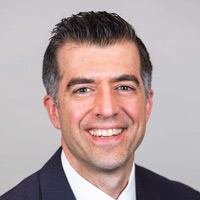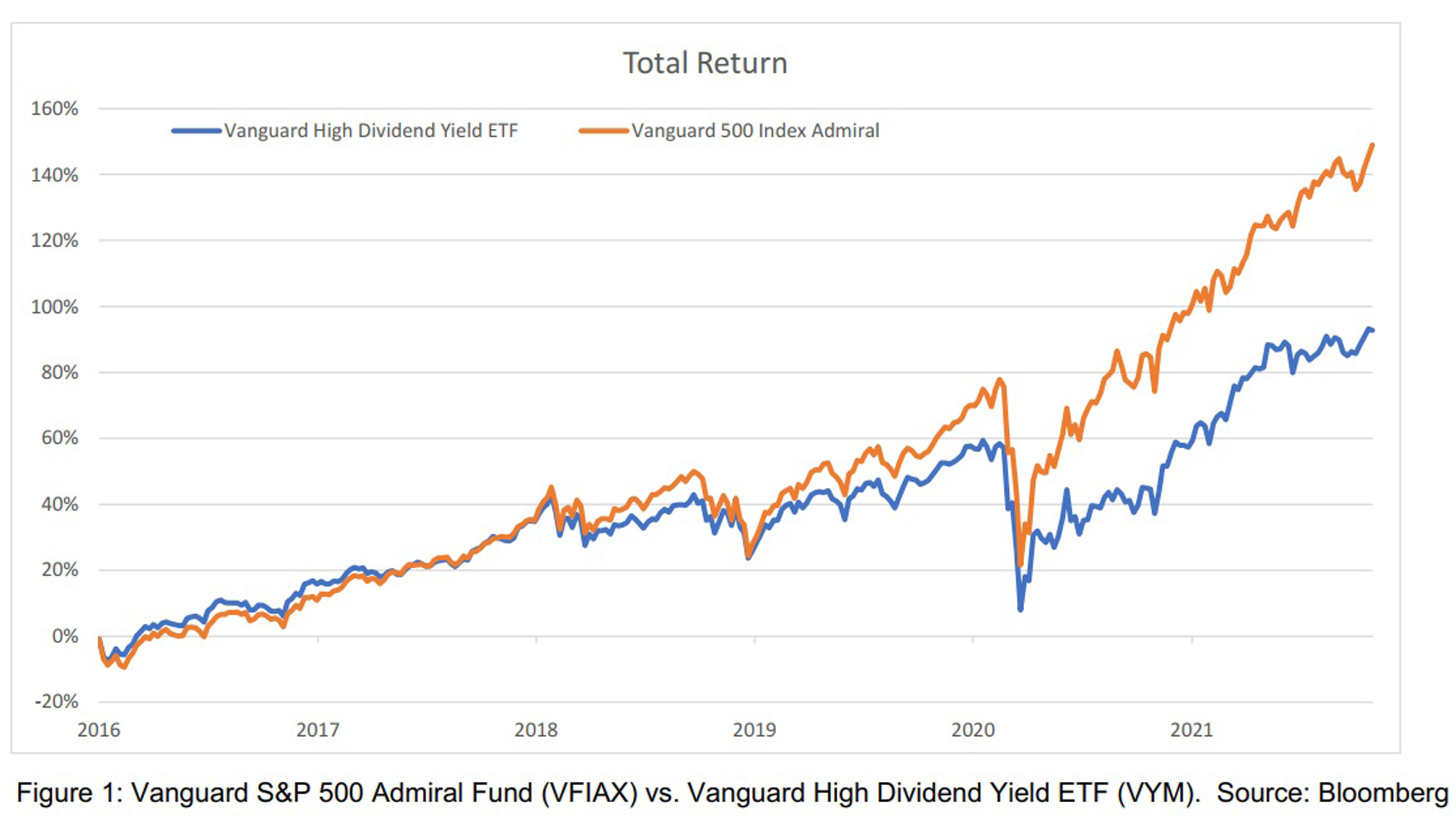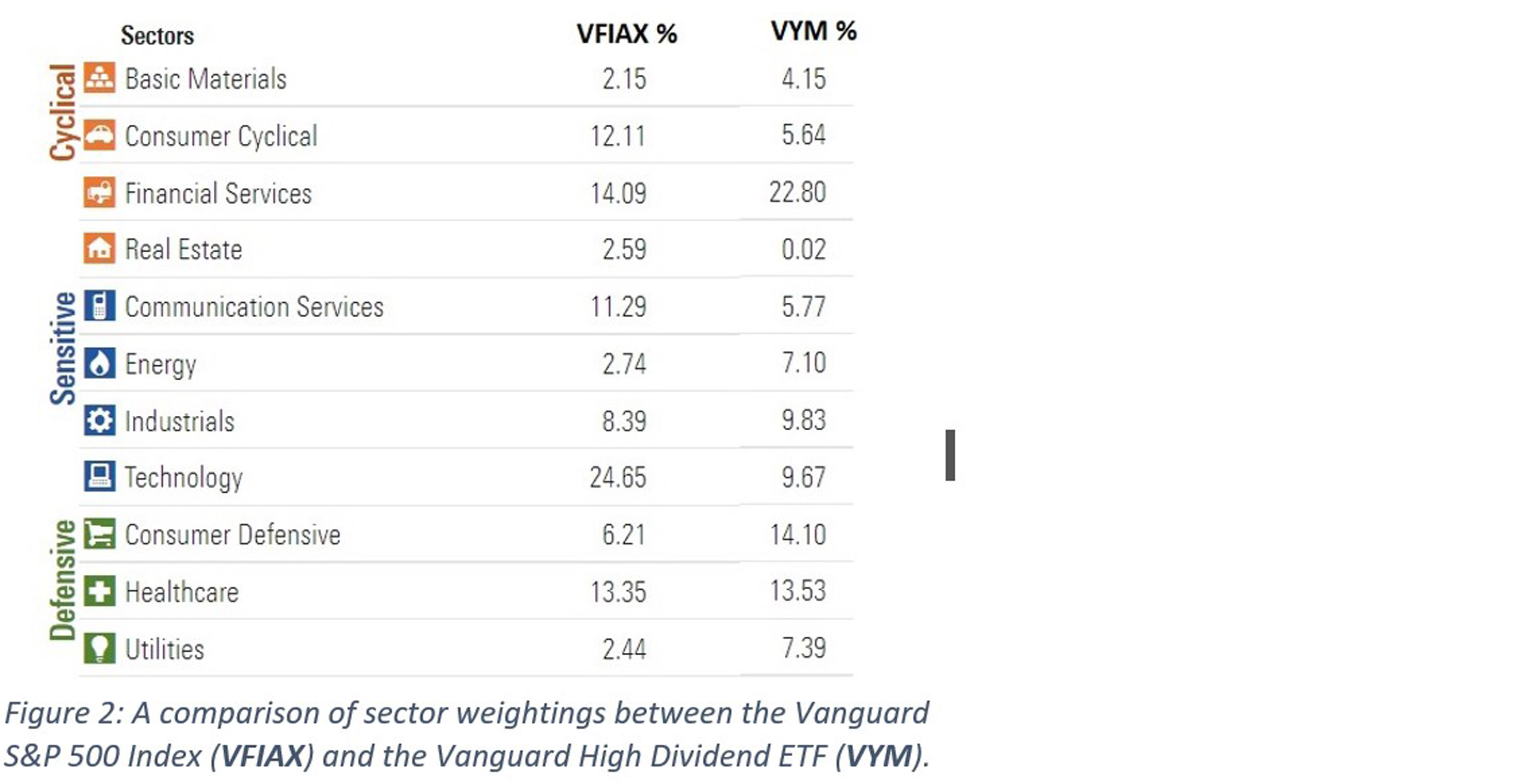The Case Against Owning All Dividend-Paying Stocks in Retirement
Income investors are often all about dividends, but that may not be a smart strategy for retirees. Here’s why, and what investment model they should consider instead.


I host various seminars for retirees. At every seminar, one retiree always raises his or her hand and tells me they recently loaded up on dividend-paying mutual funds and preferred stocks. I shake my head and wish them luck.
I understand the logic but disagree. The last few years bear this out. Since 2016, the Vanguard High Dividend Yield ETF (VYM) – which owns high-dividend-paying stocks – has severely underperformed the broad market as measured by the Vanguard S&P 500 Index fund (VFIAX) (see Figure 1). Dividend investors in VYM gave up a tremendous amount in overall performance and diversification.

For this reason, I tell investors who are in retirement not to take an income-only approach. Instead, consider a core-and-satellite investment strategy like the one I outline below, or tune into our complimentary retirement planning webinar on Nov. 16 to learn more (register here).

Sign up for Kiplinger’s Free E-Newsletters
Profit and prosper with the best of expert advice on investing, taxes, retirement, personal finance and more - straight to your e-mail.
Profit and prosper with the best of expert advice - straight to your e-mail.
Dividend investing versus the broad market
It’s all about balance. If we go all in on dividend-paying stocks and mutual funds, our dividend income may increase, but at the expense of overall portfolio appreciation and diversification. Figure 1 bears this out. Many technology stocks are not high-dividend-paying stocks and are not in the Vanguard High Dividend Yield ETF. In other words, investors in the high-dividend fund missed the tech run. The S&P 500 index fund grew 70% more versus the high-dividend ETF over the past five years.
Dividend mutual funds lack diversification
Many dividend-focused mutual funds and ETFs own a greater proportion of bank, energy and utility companies than the index. The Vanguard High Dividend Yield ETF (VYM), as of Sept. 30, 2021, had about 1.5 times more in in financial service companies and roughly three times as much in energy and utility companies as the Vanguard S&P 500 Index (see Figure 2). The high dividend ETF also owns significantly less in tech: 9.67% versus 24.65%.

This is no surprise since banks, utility and energy stocks usually have higher dividends than tech stocks. However, since 2016 those bank and energy stocks did not perform as well as tech stocks. This year is a little different as energy stocks have soared.
The key is to be aware that owning dividend-paying mutual funds can lead to a portfolio that tilts heavily to three sectors of the economy. As a result, the performance can vary significantly from the broad benchmark and rely heavily on the health of banks, energy and utility companies. Granted, the S&P 500 Index owns a significant amount of tech right now. That too is a concern and something investors need to be aware of.
Therefore, I advocate for a more balanced core portfolio, adding income satellites for retirees where it makes sense. Here’s how that works:
Create a good core
Instead of a focusing on income-only investments, retirees should hold the bulk of their nest egg in a core portfolio of low-cost broadly diversified index funds. For my core, I use large cap indexes, small cap indexes, international and emerging market indexes. I also use equal-weighted indexes. Equal weighting is a simple idea: We buy the same dollar value in each stock, representing an equal part of the value of the portfolio. Equal weighting reduces the glaring overexposures to tech, banks and energy stocks I mentioned earlier. I may also build my own index, which gives me more control of the sector allocations.
I also add in various active and passive fixed income managers, as well as active equity managers where it makes sense, like in ESG, or a specialty strategy, such as hedging or merger arbitrage. I then adjust the allocations as time goes on depending on performance and perceived opportunities. This is my core portfolio. A good core should keep pace with the broad market, but with less risk than the broad market.
Create income satellites
If you have a strong core, you can round out your portfolio using satellites. A satellite is a tilt or a slight overweight in the portfolio. For my retired clients, I may recommend a high-dividend-paying individual stock manager or ETF as a satellite. I like individual stocks and ETFs for their tax efficiency. An individual stock manager can use tax-loss harvesting to minimize taxes. ETFs are typically more tax friendly than mutual funds. There are also passive dividend index mutual funds that can work.
Preferred stocks are a satellite. Preferred stock is a separate class of stock that companies issue. Preferred stock has higher yields than regular common stock, usually around 3%-5%. There are different risks with preferred stocks, such as interest rate risk, so be sure to do your homework.
Real estate investment trusts (REITs) are a good income satellite for retirees, too. REITs have high yields, usually 4%-5%. I typically recommend retirees have 2%-5% of their overall portfolio in REITs. That’s enough of a tilt to boost the income and diversification, but not enough to wreak havoc on the overall portfolio if the sector performs badly. There are several types of REITs, such as multi-family housing, warehousing and data centers, active and passive mutual funds, and ETFs. I usually mix in all the above.
Focus on total return, not income
Instead of focusing on income, I tell my clients to focus on total return. In a good year for the stock market, such as 2019, 2020 and so far 2021, I take the profits or gains from the portfolio and my clients use them for spending. In a bad year, we may take less from the portfolio or use our bonds and cash, so our stocks have time to recover.
I prefer the total return approach because dividend and interest income are usually not enough to cover clients’ lifestyle expenses. Taking profits is also like rebalancing. It reduces our risk. For the past five years taking profits from growth stocks has reduced our exposure to IT and software companies. This approach didn’t help the portfolio grow, but it did reduce our risk of being overexposed to tech – risk of loss is something I find retirees usually care more about than performance.
Conclusion
Unless you have a strong conviction about financial, energy and utility companies, I would steer away from high-dividend-yielding funds and ETFs for the bulk of your money. Instead, try a core-and-satellite approach. A good core is well-balanced and well-diversified across industries, large and small companies, and domestic and foreign stocks. Consider adding income satellites like high-dividend stocks, preferred stocks and REITs in small amounts. Satellites can increase the portfolio income without changing the risk too much. It’s all about balance.
Disclaimer
Investment advisory and financial planning services are offered through Summit Financial LLC, an SEC Registered Investment Adviser, 4 Campus Drive, Parsippany, NJ 07054. Tel. 973-285-3600 Fax. 973-285-3666. This material is for your information and guidance and is not intended as legal or tax advice. Clients should make all decisions regarding the tax and legal implications of their investments and plans after consulting with their independent tax or legal advisers. Individual investor portfolios must be constructed based on the individual’s financial resources, investment goals, risk tolerance, investment time horizon, tax situation and other relevant factors. Past performance is not a guarantee of future results. The views and opinions expressed in this article are solely those of the author and should not be attributed to Summit Financial LLC. Links to third-party websites are provided for your convenience and informational purposes only. Summit is not responsible for the information contained on third-party websites. The Summit financial planning design team admitted attorneys and/or CPAs, who act exclusively in a non-representative capacity with respect to Summit’s clients. Neither they nor Summit provide tax or legal advice to clients. Any tax statements contained herein were not intended or written to be used, and cannot be used, for the purpose of avoiding U.S. federal, state or local taxes.
Get Kiplinger Today newsletter — free
Profit and prosper with the best of Kiplinger's advice on investing, taxes, retirement, personal finance and much more. Delivered daily. Enter your email in the box and click Sign Me Up.

Michael Aloi is a CERTIFIED FINANCIAL PLANNER™ Practitioner and Accredited Wealth Management Advisor℠ with Summit Financial, LLC. With 21 years of experience, Michael specializes in working with executives, professionals and retirees. Since he joined Summit Financial, LLC, Michael has built a process that emphasizes the integration of various facets of financial planning. Supported by a team of in-house estate and income tax specialists, Michael offers his clients coordinated solutions to scattered problems.
-
 6 Stunning Waterfront Homes for Sale Around the US
6 Stunning Waterfront Homes for Sale Around the USFrom private peninsulas to lakes, bayous and beyond, Kiplinger's "Listed" series brings you another selection of dream homes for sale on the waterfront.
By Charlotte Gorbold Published
-
 Six Reasons to Disinherit Someone and How to Do It
Six Reasons to Disinherit Someone and How to Do ItWhether you're navigating a second marriage, dealing with an estranged relative or leaving your assets to charity, there are reasons to disinherit someone. Here's how.
By Donna LeValley Published
-
 Should You Still Wait Until 70 to Claim Social Security?
Should You Still Wait Until 70 to Claim Social Security?Delaying Social Security until age 70 will increase your benefits. But with shortages ahead, and talk of cuts, is there a case for claiming sooner?
By Evan T. Beach, CFP®, AWMA® Published
-
 Retirement Planning for Couples: How to Plan to Be So Happy Together
Retirement Planning for Couples: How to Plan to Be So Happy TogetherPlanning for retirement as a couple is a team sport that takes open communication, thoughtful planning and a solid financial strategy.
By Andrew Rosen, CFP®, CEP Published
-
 Market Turmoil: What History Tells Us About Current Volatility
Market Turmoil: What History Tells Us About Current VolatilityThis up-and-down uncertainty is nerve-racking, but a look back at previous downturns shows that the markets are resilient. Here's how to ride out the turmoil.
By Michael Aloi, CFP® Published
-
 Stock Market Today: Stocks Surge to Close a Volatile Week
Stock Market Today: Stocks Surge to Close a Volatile WeekIt was another day with a week's worth of both news and price action, but it ended on a strongly positive note.
By David Dittman Published
-
 Home Insurance: How to Cut Costs Without Losing Coverage
Home Insurance: How to Cut Costs Without Losing CoverageNatural disasters are causing home insurance premiums to soar, but don't risk dropping your coverage completely when there are ways to keep costs down.
By Jared Elson, Investment Adviser Published
-
 Markets Roller Coaster: Resist the Urge to Make Big Changes
Markets Roller Coaster: Resist the Urge to Make Big ChangesYou could do more harm than good if you react emotionally to volatility. Instead, consider tax-loss harvesting, Roth conversions and how to plan for next time.
By Frank J. Legan Published
-
 Why Homeowners Insurance Has Gotten So Very Expensive
Why Homeowners Insurance Has Gotten So Very ExpensiveThe home insurance industry is seeing more frequent and bigger claims because of weather, wildfires and other natural disasters.
By Karl Susman, CPCU, LUTCF, CIC, CSFP, CFS, CPIA, AAI-M, PLCS Published
-
 Stock Market Today: Uncertainty Proliferates: Dow Loses 1,014 Points
Stock Market Today: Uncertainty Proliferates: Dow Loses 1,014 PointsWeaker-than-expected consumer inflation data wasn't enough to stabilize sentiment during another volatile day for financial markets.
By David Dittman Published